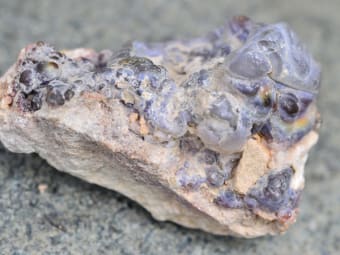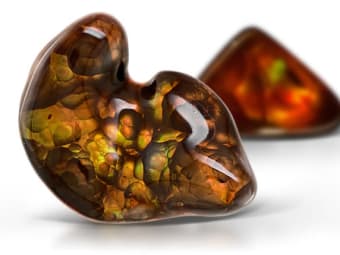Introduction
The title picture for this article is one of the best illustrations of fire agate we have seen. It is a custom-made Fire Agate Ring by Master Cutter, Richard Krukowski Fire Agate Art Studio, and the photograph is his too.
Now "agate" is the term used to describe the banded form of chalcedony, however, fire agate is not banded nor does it display any fire in the rough. It is typically an unprepossessing rock similar to the rough shown below in another picture from Ryszard Krukowski. That is one reason it was not documented as a gemstone until the early 1940s. It took cutters a long time to learn how to cut the stone and maximize its iridescence potential. The ring illustrated in the title picture shows just how well a master like Ryszard can work with this material.

What is Fire Agate?
Mineralogist Joel Arem describes fire agate as chalcedony layered with platy crystals of iron oxide resulting in iridescence brought out by cutting and polishing. Ryszard Krukowski's ring, is an example of how beautiful fire agate can be after a skilled cutter follows the contours and layering of the stone using a variety of diamond dental sanding disks, drills and wheels. Even when looking at the commercial to low quality range, as illustrated by the Author Renee Newman below when she photographed examples at a gem show, this stone surprises and delights. Fire agate has a predominantly brown color with varying amounts of colorful iridescence within caused by thin film interference.

Where is Fire Agate found?
Fire agate is found in Arizona in the U.S. as well as the states of Aguascalientes, Chihuahua, Jalisco and San Luis Potosi in Mexico. It has also been found in California and New Mexico.
The two main mining locations for fire agate in Arizona are Deer Creek, located in the Galiuro Mountains and Slaughter Mountain, located near Globe on the San Carlos Indian Reservation; the latter is also famous for its peridot. The mining areas are about 100 miles apart from each other in southeastern Arizona, and each mine produces stones with very distinct characteristics.
Caring For Fire Agate
Fire agate is harder and wears better than other stones with optical effects such as opal and ammolite. The GIA Gem Reference Guide, says that it is usually safe to clean chalcedony with ultrasonics and steamers, but warns that it is attacked by hydrofluoric acid, which jewelers might use, but is unlikely to be used in a domestic setting.
From an expert's perspective, Krukowski, who has had more than 40 years’ experience cutting, setting and selling fire agate and he has not experienced any problems with it scuffing, cracking or abrading with normal wear and tear. However, he does not recommend firing stones with metal casting/sculpting clay because the extreme heat would crack the fire agate. While Krukowski has successfully re-sized a ring set with fire agate by wrapping the stone in wet paper/cloth to keep it cool, it is probably advisable for less experienced jewelers to remove fire agate before sizing rings.
Even though fire agate is a very durable stone, like any other gemstone, it’s best to avoid hard wear and sharp blows in order to maintain the beauty of your fire agate jewelry.
How is Fire Agate Formed?
Fire agate was formed as the result of volcanic activity that occurred millions of years ago. Due to extreme volcanic activity in some areas, hot water with silica and iron oxide seeped into cracks and cavities of certain rocks below the Earth’s surface. Layers of chalcedony with crystals of iron oxide formed as the solution cooled. A unique mix of ingredients with the right temperatures and temperatures allowed the agate to cool in bubbly, grape-like formations that are described as "botryoidal" by mineralogists. The brown areas of the chalcedony are caused by the iron oxide.
How To Identify Fire Agate

Fire agate is one of the easiest stones to identify because of its unique bubbly brown appearance and distinctive iridescent colors. It is unlikely to be confused with anything apart from, perhaps, fire opal in matrix. It is generally translucent to semi-opaque and has the same gemological properties as other chalcedonies:
Refractive Index: 1.53–1.54
Specific gravity: 2.55– 2.69
Hardness: 6.5–7.0
Cleavage: none
Pleochroism: none
Value. What Is Fire Agate Worth?
Fire agate is generally an affordable gem, but in extra fine qualities, large stones and carvings can cost several thousand dollars. The gems may be priced either by the carat or the piece. Small low-grade stones with hardly any iridescence may sell for less than $20 each. Prices vary widely depending on the seller and the following factors:
- Fire agate is predominately brown with fairly common iridescent colors of orange, orangy red, gold or goldy green. Fire colors that are pure green or dark red are harder to find. Strong blue, purple and pink are even more rare and in high demand. A pure sulfur yellow is perhaps the rarest fire color of all.
- In general, the more colors displayed, the higher the price if the brightness is the same.
- The brightness is more important than the number of colors. A fire agate with one or two intense bright colors can sell for more than a stone with three or more dull colors.
- The best stones retain their color and brightness no matter where they are viewed. Blues and purples that can retain their color even in dim light are especially prized.
- Fire agates are typically priced by the amount of iridescence visible over the surface of the stone. The more iridescence there is, the higher the price. Full fire is the ideal, but is rarely achieved.
- Full nodules can command higher prices than those that have partial or incomplete shapes.
- Cracks, chips and dead spots are the most serious type of imperfection and lower the value of the stone.
- Standard cabochon shapes do not often occur naturally in the rough and must be specially cut. These sometimes sell for less because fire may have been lost or cut through to make the shape. Free-forms that follow the contours of the iron oxide layers and the shape of the nodules tend to sell for more because they generally display more fire and are a complete stone.
- The quality of the cutting and polish is an important aspect of a fire agate’s value because that has a major impact on the brilliance and display of iridescence. Considering the amount of time it takes to cut a fire agate skillfully, it is only natural that well-cut stones will fetch higher prices than those with mediocre cutting and polish.
- Larger and heavier stones naturally can sell for more than those that are smaller and weigh less.


Metaphysical Properties of Agate
Fire agate is a relatively new gemstone so there are no historical beliefs about its spiritual and talismanic properties. However, According to The Curious Lore of Precious Stone by George Frederick Kunz, agate was believed to possess wonderful virtues. Wearing agate ornaments could help:
- Cure insomnia
- Ensure pleasant dreams
- Attract riches
- Neutralize the power of the Evil Eye
- Endow the wearer with a bold heart leading one to victory
- Guard the wearer from all dangers
